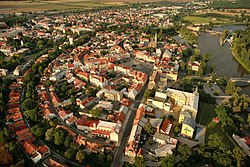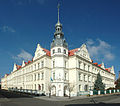Nymburk
Nymburk | |
|---|---|
 Aerial view of Nymburk | |
 Flag  Coat of arms | |
 Nymburk Location in the Czech Republic | |
| Coordinates: 50°11′10″N 15°2′30″E / 50.18611°N 15.04167°ECoordinates: 50°11′10″N 15°2′30″E / 50.18611°N 15.04167°E | |
| Country | |
| Region | Central Bohemian |
| District | Nymburk |
| Founded | Around 1275 |
| Government | |
| • Mayor | Tomáš Mach |
| Area | |
| • Total | 20.59 km2 (7.95 sq mi) |
| Elevation | 193 m (633 ft) |
| Population (2021-01-01)[1] | |
| • Total | 15,106 |
| • Density | 730/km2 (1,900/sq mi) |
| Time zone | UTC+1 (CET) |
| • Summer (DST) | UTC+2 (CEST) |
| Postal code | 288 02 |
| Website | www |
Nymburk (Czech pronunciation: [ˈnɪmburk]; German: Nimburg, Neuenburg an der Elbe) is a town in the Central Bohemian Region of the Czech Republic. It has about 15,000 inhabitants. It is located 45 km (28 mi) east of Prague on the Elbe River. The town centre is well preserved and is protected by law as an urban monument zone.
Administrative parts[]
The town is made up of two town parts: Nymburk and Drahelice.
History[]

The town was founded in around 1275 by the Bohemian King Ottokar II. Throughout the Middle Ages it was one of the most important towns in the kingdom. Nymburk was a strategic town protecting Prague and an important pillar of royal power.[2]
During the reign of Wenceslaus II, the Gothic Church of St. Nicholas (today Church of St. Giles) and Dominican Monastery were constructed. The town was surrounded by burnt-brick walls with about fifty towers and two defensive ditches, fed from the Elbe. The Hussite Wars in the 15th century affected the town only slightly (the Dominican monastery was looted) and so the town prospered until the beginning of the 17th century.[2]
During the Thirty Years' War, Nymburk was burned and looted, the fortress was almost destroyed and the walls demolished. The recovery was disrupted by large fires. The turning point in modern history was the introduction of the railway to the town in 1870. Since then, the town has grown, new buildings have been built, the river Elbe has been regulated, a new bridge and a hydroelectric power plant with a lock chamber have been built. The construction started to expand beyond the strip of walls. However, the original medieval floor plan has been completely preserved.[2]
Demography[]
|
|
| ||||||||||||||||||||||||||||||||||||||||||||||||||||||
| Source: Historical lexicon of municipalities of the Czech Republic[3] | ||||||||||||||||||||||||||||||||||||||||||||||||||||||||
Economy[]
In the southern part of the town is located the Nymburk Brewery. It was founded in 1895 and with the production of about 200,000 hl/year it ranks among the medium-sized breweries. The brewery produces beer under the brand Postřižinské.[4]
JDK is a large company that manufactures refrigeration equipment in Nymburk and exports it all over the world. Since 2005, the Chinese company Changhong has been doing here the final assembly of LCD TVs for the whole European market.
Transport[]
Nymburk is the important railway junction and lies at the crossroads of four railway lines. Roads that pass through the town: I/38, II/330 and II/331. Urban transport is provided only by buses.
Sport[]
The town is home to Basketball Nymburk, a club that won the last 16 National Basketball Leagues. It plays its home games at the Sportovní Centrum. For some of its highlight games, the club moves to the Královka Arena in Prague.
Since 2015,[5] an annual international rink bandy tournament takes place in Nymburk. In 2017, Federation of International Bandy has decided to make the tournament official.[6]
The town's football club is SK Polaban Nymburk. It plays on the fourth tier of the Czech football system.
Sights[]

The dominant feature of the town is the Gothic brick Church of Saint Giles, built in 1280–1380. This church, together with the preserved buildings of the Nymburk fortification, is unique example of brick Gothic (originally North German) architecture in the Czech lands. The dominant of the square is a rare Renaissance town hall from 1526.[2]
Besides town walls, the town is also dominated by the road bridge (cultural heritage) from 1913, which connects the town centre with a town part of Zálabí. Among the important cultural monuments of Nymburk are also Turkish tower (former waterworks from 1597), Plague column (built in 1717), Chapel of St. John of Nepomuk (originally a part of Dominican monastery), Bohumil Hrabal Grammar School, Nymburk Synagogue, Tourist Information Centre house, water tower and Old Fisher House.[2]
In literature[]
Bohumil Hrabal, who grew up in the town, wrote about Nymburk proses The Little Town Where Time Stood Still, Cutting It Short, Beautiful Sadness, Harlequin's Millions and Closely Watched Trains.
Notable people[]
- Bohuslav Matěj Černohorský (1684–1742), composer and organist
- Karel Dostal (1884–1966), actor
- Bohumil Hrabal (1914–1997), writer, lived here in childhood and youth
- Miroslav Macháček (1922–1991), theatre director and actor
- Vratislav Effenberger (1923–1986), literature theoretician
- Radek Bejbl (born 1972), footballer
- Jan Bořil (born 1991), footballer
Twin towns – sister cities[]
 Mytishchi, Russia
Mytishchi, Russia Neuruppin, Germany
Neuruppin, Germany Porto San Giorgio, Italy
Porto San Giorgio, Italy Vrútky, Slovakia
Vrútky, Slovakia Żarów, Poland
Żarów, Poland
Gallery[]
Medieval walls
Kostelní Square

Turkish tower

Plague column

Renaissance town hall

Chapel of St. John of Nepomuk

Road bridge over the Elbe

Art Nouveau water tower

Nymburk Brewery

Tourist Information Centre House

Old Fisher House

Grammar school
References[]
- ^ "Population of Municipalities – 1 January 2021". Czech Statistical Office. 30 April 2021.
- ^ Jump up to: a b c d e "Historie a současnost Nymburka" (in Czech). Město Nymburk. Retrieved 5 July 2021.
- ^ "Historický lexikon obcí České republiky 1869–2011 – Okres Nymburk" (in Czech). Czech Statistical Office. 21 December 2015. pp. 7–8.
- ^ "Hlavní strana" (in Czech). Pivovar Nymburk. Retrieved 5 July 2021.
- ^ "Turnaj v RINK BANDY v Nymburce | Česká Asociace Bandy". czechbandy.cz.
- ^ "European Rinkbandy Cup in Nymburk, Czech Republic". Archived from the original on 16 September 2018. Retrieved 12 October 2017.
- ^ "Partnerská města" (in Czech). Město Nymburk. Retrieved 6 July 2021.
External links[]
| Wikimedia Commons has media related to Nymburk. |
- Official website (in Czech)
- Populated places in Nymburk District
- Nymburk
- Cities and towns in the Czech Republic












